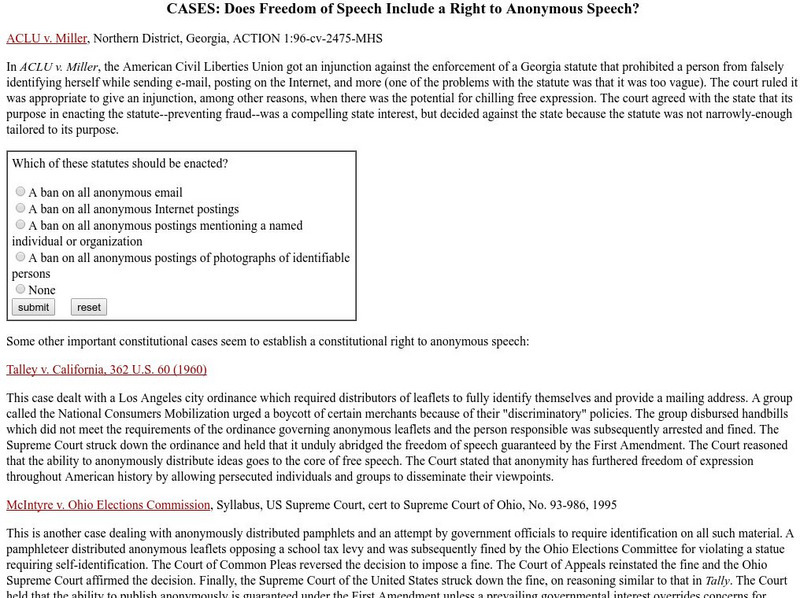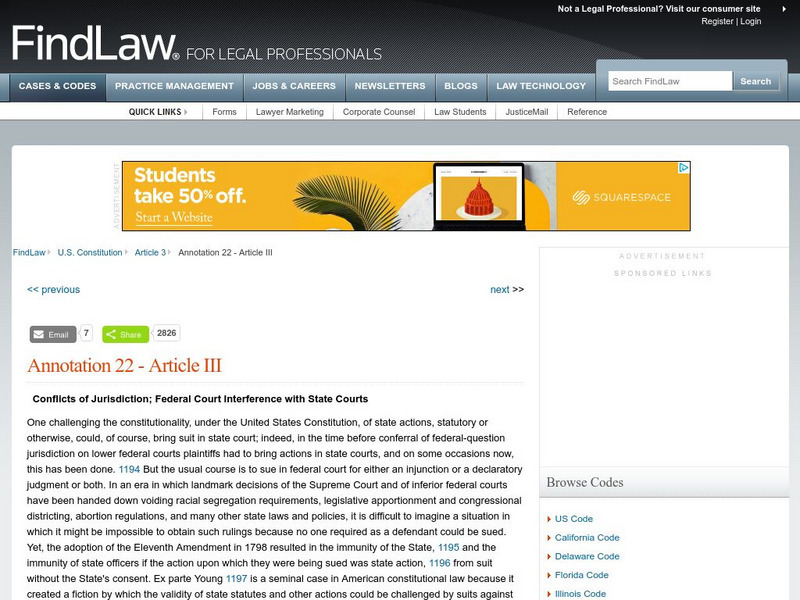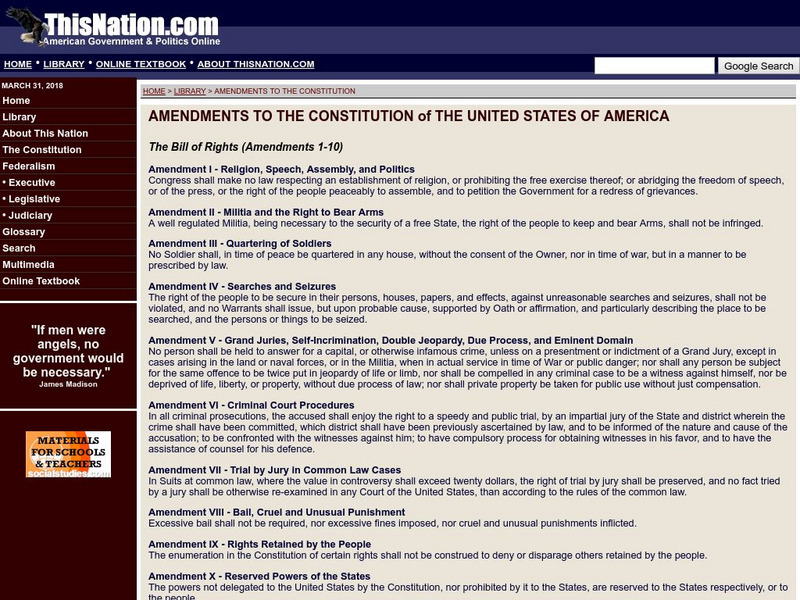Hi, what do you want to do?
iCivics
I Civics: No Bill of Rights, No Deal
In the debate over the Constitution, the Bill of Rights was a deal-breaker. In this lesson, students learn why the federalists thought the Constitution didn't need a bill of rights and why the anti-federalists refused to accept the...
TED Talks
Ted: Ted Ed: A 3 Minute Guide to the Bill of Rights
A brief video that summarizes the first ten amendments to the Constitution. [3:36] Followed by a quiz and a list of additional resources to explore.
University of Missouri
Exploring Constitutional Conflicts: Marsh v Chambers, u.s. Supreme Court
Chief Justice Burger's majority opinion in the case of MARSH vs. CHAMBERS, 463 U.S. 783 (1983). The case dealt with whether an opening prayer in the Nebraska Legislature violated the First Amendment.
PBS
Pbs Teachers: Foreign War and Domestic Freedom: (Civil Liberties Lesson Plan)
A lesson plan that directs students to review the concept of civil liberties and to examine examples from American history wherein rights were restricted. They will investigate key arguments between those who seek to restrict liberties...
Wikimedia
Wikipedia: United States Bill of Rights
This encyclopedia article from Wikipedia gives some background history to the creation of the Bill of Rights and contains a transcription of the first ten amendments to the Constitution in their original form.
Scholastic
Scholastic: Explaining the Bill of Rights
Read about the need for a Bill of Rights to be added to the Constitution. Find out what each of the first ten amendments means.
Texas State Library and Archives Commission
Texas State Library and Archives Commission: The Battle Lost and Won: The Nineteenth Amendment
After the "Susan B. Anthony" amendment was passed by the Senate, suffragists stepped up in order to persuade the states to ratify it. Read how Texas suffragist Jane Y. McCallum was part of that cause and about the opposition she faced...
University of Missouri
Exploring Constitutional Conflicts: Griswold vs. Connecticut
This site contains in-depth information about the Griswold vs. Connecticut case, concerning the right to use contraception, and its impact.
Harvard University
Harvard Law: Freedom of Speech and Anonymous Speech
This site from Cyber Harvard Law offers summaries of three different Supreme Court cases which address the limits of free speech. Includes interactive opinion, multiple-choice questions. Links to the written opinions of the Court for...
Thomson Reuters
Find Law: Jurisdiction of Federal Courts
This site describes the jurisdiction of the Federal Court system. The site breaks the court's jurisdiction into three main areas of institutional conflict: Federal Restraint of State Courts by Injunctions, Habeas Corpus: Scope of the...
Other
University of Arkansas: The Ordeal of Religious Test Oaths in Pennsylvania
An argumentative essay on the underlying premise of political theory which deals with religious test oaths.
PBS
Pbs Learning Media: Boston Public Schools Capstone Project
The (Boston Public Schools) Capstone Project is an opportunity for students to engage in rigorous project-based learning. It is an opportunity for our students to develop skills to be life, career, and college-ready in a culturally...
This Nation
This nation.com: Amendments to the u.s. Constitution
This site provides the text of all the amendments to the U.S. Constitution. The first ten are the Bill of Rights.
Mocomi & Anibrain Digital Technologies
Mocomi: The Bill of Rights
Learn about the Bill of Rights and when it was added to the Constitution.Provides a list of the ten Amendments.
Stephen Byrne
History for Kids: Bill of Rights
History for Kids reference page provides an overview of the Bill of Rights, outlining each of the ten amendments, and teaching about the history and principles of the U.S. Consitution and first ten amendments.
Wikimedia
Wikipedia: Schenck v. United States
This encyclopedia entry summarizes the landmark Supreme Court case of Schenck v. United States, which pitted the right of free speech against the 1917 Espionage Act.
Other
Common Sense Americanism: Schenck v. United States
This summary provides the background for Schenck v. United States, a World War I-era Supreme Court case involving free speech. Schenck is an example of what can happen to basic constitutional rights in time of war.
iCivics
I Civics: Hazelwood School District v. Kuhlmeier (1988)
This mini-lesson covers the basics of the Supreme Court's decision that established a school principal's right to censor student articles in the school newspaper. Students learn about the limits on student free speech in a school...
Ducksters
Ducksters: Us Government for Kids: United States Bill of Rights
Kids learn about the Bill of Rights of the United States government. The first 10 amendments to the Constitution.
Savvas Learning
Changing Views of Free Speech
An easy to follow flow chart that shows how the idea of freedom of speech has changed throughout the years. Make sure to click on each box of information to get a more in depth description.
Scholastic
Scholastic: Geraldine Ferraro
Biographical sketch of the first woman vice-presidential candidate on a national party ticket in America.
PBS
Pbs Teachers: Freedom to Worship (Lesson Plan)
A lesson plan designed to investigate the conditions and difficulties facing immigrants who have sought religious freedom in the United States throughout history. Requires viewing of select segments from "Destination America," the...
Thomson Reuters
Find Law: u.s. Supreme Court: Gannett Co. V. De Pasquale (1979)
Complete Supreme Court opinion for Gannett Co. V. DePasquale.
Other
Insight: Should There Be a Chaplain in Congress?
This site discusses the issue of whether having a chaplain in the Congress is contradictory to the First Amendment. It includes a discussion of the related Supreme Court case, Marsh vs. Chambers. (Published March 20, 2000)
























